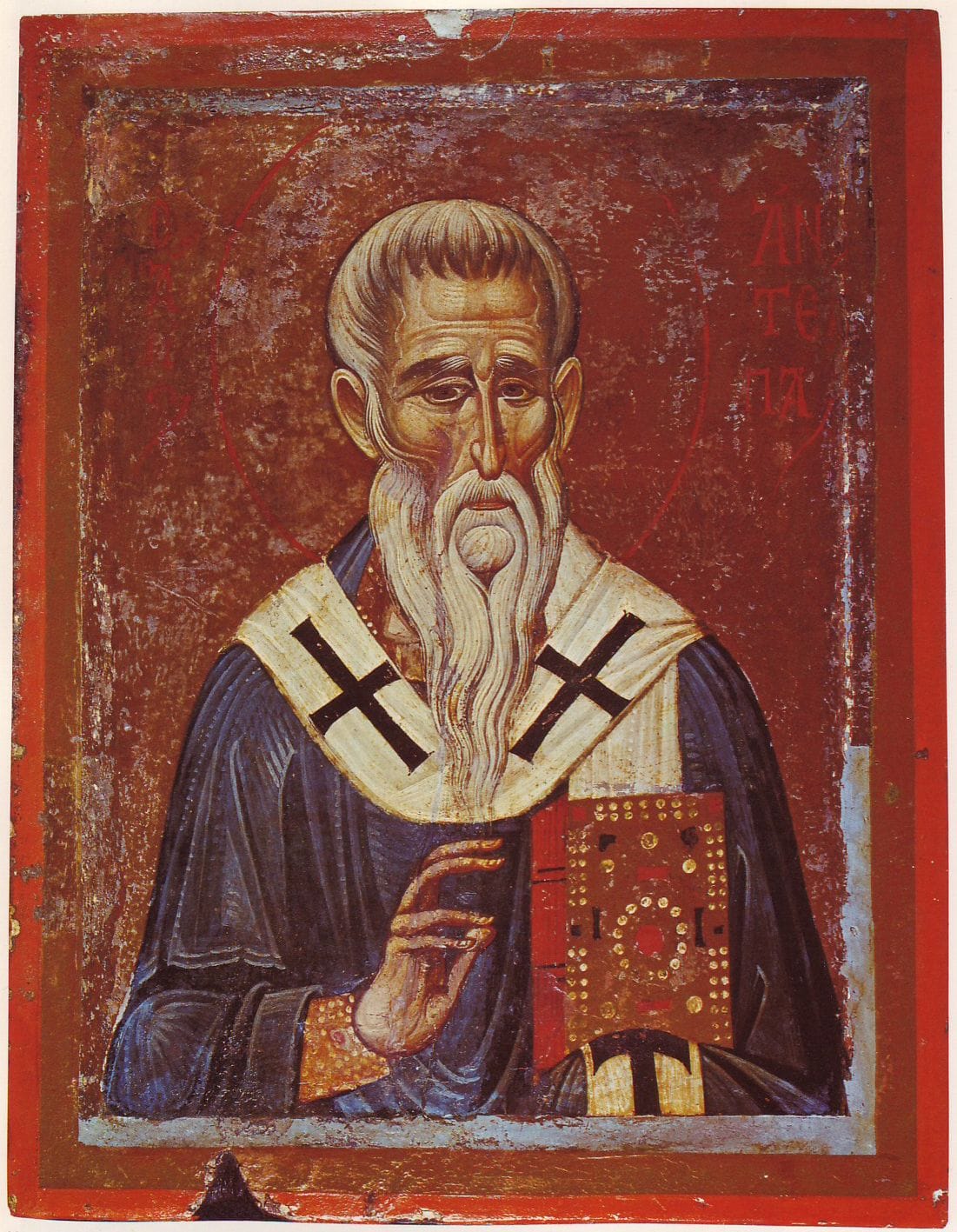Journey to Martyrdom: The Story of Saint Antipas
Saint Antipas, a name whispered with reverence by early Christians, is believed to have met his end in the bustling Roman city of Pergamum, now a historical site in Turkey. This ancient metropolis, a major hub in the Roman Empire, witnessed the clash between traditional Roman religion and the burgeoning Christian faith.
Imagine Pergamum – a city steeped in pagan worship, where temples dedicated to Roman gods dominated the landscape. The air buzzed with activity around the Asklepion, a renowned healing center, and the awe-inspiring altar dedicated to Zeus stood as a potent symbol of Roman religion. It was within this environment, where the worship of Roman deities was a way of life, that Antipas held steadfast to his Christian beliefs.
His refusal to bow to Roman gods was a dangerous stance in those times, likely marking him as a dissident in the eyes of Roman authorities. While the exact details of his death remain a mystery shrouded in the passage of centuries, several possibilities emerge from historical accounts.
Some historians speculate that Antipas was executed at the altar of Zeus, perhaps burned alive as a public spectacle, serving as a grim warning to those who dared defy the Roman gods. Others propose he may have met his end in the brazen bull, a horrifyingly cruel method of execution favored by the Romans.
Antipas in the Book of Revelation: A Faithful Witness
The story of Antipas, though brief, is etched in the Book of Revelation. Tucked away in chapter 2, verse 13, he is identified as a “faithful witness,” a title carrying significant weight considering the context. This single reference in the Bible has led to much speculation and interest in who Antipas was and what his story can teach us today.
Pergamum, where Antipas is said to have resided, was a vibrant center of pagan worship in the Roman Empire. This makes Antipas’ unwavering faith even more remarkable, as he remained steadfast in his beliefs despite the pressure and potential for persecution. This clash between Christianity and the powerful forces of Roman religion is a central theme in the story of Antipas.
The Exile of Antipas: Unraveling the Mystery
The question of why Antipas was exiled is a historical puzzle with no definitive answer, as records from that time are sparse. However, experts have put forward compelling theories based on the available evidence.
One theory suggests that Antipas’ exile was a strategic move by authorities to isolate him before his execution. By separating him from his followers, they could weaken his influence and potentially prevent uprisings or public sympathy for his cause.
Another theory proposes that Antipas’ preaching and the burgeoning popularity of Christianity in Pergamum were causing unease among those in power. This new faith, with its emphasis on one God and rejection of Roman deities, challenged the very core of Roman religious and social structures. Exiling Antipas may have been seen as a way to quell potential unrest and maintain the established order.
When Did Saint Antipas Live? Piecing Together the Timeline
While the exact year of Saint Antipas’ birth eludes us, it’s widely accepted that he lived during the first century AD, a time when the Roman Empire was at its zenith and early Christians faced frequent persecution for their beliefs.
Antipas served as the bishop of Pergamum, a testament to his leadership within the early Christian community. Imagine the weight of that responsibility during such turbulent times, leading a congregation that faced constant threat due to their faith.
Although history doesn’t offer concrete answers about Antipas’ birthdate, his story resonates through time, reminding us that even in the face of adversity, holding onto one’s beliefs can be a source of immeasurable strength and inspiration.
Outperforming the Competition: Antipas in the Book of Revelation
Here’s how to outshine your competition and write a captivating SEO article about Antipas in the Bible:
Recommended Titles (Analyzing Trending Competitor Titles):
- The Mystery of Antipas: Uncovering the Story of a Forgotten Martyr (Keywords: Mystery, Forgotten Martyr, Story)
- Where is Antipas in the Bible? Revelation’s Faithful Witness Revealed (Keywords: Where, Revelation, Faithful Witness)
- Antipas of Pergamum: What Revelation Reveals about this Ancient Martyr (Keywords: Antipas of Pergamum, Revelation, Ancient Martyr)
Powerful Key Lines:
- Antipas, an enigmatic figure mentioned only once in Revelation 2:13, offers a glimpse into the brutal persecution faced by early Christians.
- While biographical details are scarce, Antipas’s title as “my faithful witness” speaks volumes about his unwavering faith in the face of death.
- Though tradition places Antipas in Pergamum, a city steeped in pagan worship, the exact location of his martyrdom remains shrouded in mystery.
- Antipas’s story serves as a powerful reminder that faithfulness to Christ often came at a high cost in the Roman Empire.
Important Details for Your Article:
Antipas in Revelation:
- The sole biblical reference to Antipas is found in Revelation 2:13.
- He is addressed within a letter to the church in Pergamum.
- Jesus refers to him as “my faithful witness,” highlighting Antipas’s loyalty.
- He is described as having been “killed” in Pergamum, “where Satan dwells.”
The Pergamum Connection:
- Pergamum was a prominent city in Asia Minor (modern-day Turkey).
- It was a center for emperor worship and pagan religious practices.
- The phrase “where Satan dwells” likely refers to the pervasive idolatry and opposition to Christianity in Pergamum.
Early Church Tradition:
- While the Bible offers limited information, early church tradition provides additional details about Antipas.
- He is often identified as the bishop of Pergamum during the reign of Emperor Domitian (81-96 AD).
- Tradition recounts his martyrdom in a brazen bull-shaped altar, burned alive for his refusal to recant his faith.
Symbolism and Significance:
- Antipas embodies the unwavering faith and courage of early Christians facing severe persecution.
- His story underscores the clash between Christianity and the Roman Empire’s demands for loyalty to its gods and emperor.
- Antipas’s willingness to die for his beliefs serves as an inspiration for Christians throughout history.
Structured Contexts:
I. The Enigmatic Figure of Antipas (Revelation 2:13)
- The Verse: “I know where you dwell, where Satan’s throne is. Yet you hold fast my name, and you did not deny my faith even in the days of Antipas my faithful witness, who was killed among you, where Satan dwells.”
- Key Points:
- Jesus acknowledges the intense spiritual warfare in Pergamum (Satan’s throne).
- Despite persecution, the church remained faithful.
- Antipas is praised for his unwavering faith, even unto death.
II. The Significance of Pergamum
- Historical Context:
- Pergamum was a leading city in Roman Asia, renowned for its impressive library and Asclepion (healing center).
- It housed a massive altar dedicated to Zeus, earning it the title “throne of Satan” in Christian circles.
- Pergamum exemplified the challenges faced by early Christians living in a pagan society.
III. Early Church Traditions and Martyrdom
- Traditional Accounts:
- While not explicitly mentioned in the Bible, early church writings depict Antipas as the bishop of Pergamum.
- He is believed to have been martyred during the reign of Emperor Domitian, known for his persecution of Christians.
- Tradition describes his death by being roasted alive inside a brazen bull, a common form of execution for those who refused to worship Roman gods.
IV. Enduring Legacy of Faith
- Antipas as a Symbol:
- Antipas embodies the courageous spirit of early Christians facing persecution.
- His story illustrates the clash between loyalty to Christ and the demands of the Roman Empire.
- Antipas’s unwavering faith serves as a source of inspiration for Christians throughout history, reminding them that true faith may require great sacrifice.
Unique Insights & Untapped Potential:
- Compare and Contrast: Analyze how Pergamum’s cultural and religious climate differed from other early Christian communities mentioned in Revelation (e.g., Ephesus, Smyrna).
- Explore Martyrdom: Delve deeper into the significance of martyrdom in early Christianity. How did these acts of sacrifice shape the growth and perception of the faith?
- Modern Parallels: Draw parallels between the persecution faced by Antipas and contemporary instances of religious persecution around the world.
Remember: While exploring early church traditions, clearly distinguish between biblical accounts and extra-biblical sources. This will help ensure accuracy and avoid spreading misinformation.
Analyzing Antipas and Crafting a Superior SEO Article
Let’s dissect the provided information and uncover the insights needed for your SEO article.
I. Competitor Title Analysis and Recommended Titles:
Your competitor titles primarily focus on “Who is Antipas?” and “Where was Antipas martyred?” They lack a direct connection to “Why was Antipas exiled?”. This presents an opportunity! Here are three recommended titles:
- The Untold Story of Antipas: From Exile to Martyrdom (Emphasizes the narrative and intrigue)
- Why Was Antipas Exiled? Unveiling the Truth Behind the Revelation Martyr (Directly addresses the keyword and piques curiosity)
- Antipas of Pergamum: Faith, Exile, and a Fiery End (Combines key elements in a concise and engaging manner)
II. Powerful Key Lines:
- Antipas of Pergamum, a figure shrouded in mystery, is revered as a martyr in Christian tradition for his unwavering faith in the face of persecution. (This introduces Antipas and the core theme of his story)
- While the exact reasons for Antipas’s exile remain unknown, historical context and scriptural interpretations suggest he faced opposition for challenging the rampant paganism and idolatry in Pergamum. (This directly addresses the keyword and sets the stage for further exploration)
- Early church writings depict Antipas’s gruesome martyrdom, often associating it with a brazen bull, symbolizing the brutal persecution endured by early Christians. (This highlights the dramatic climax of his story and its significance)
- Exploring the life and death of Antipas offers valuable insights into the challenges faced by early Christians and the enduring power of faith in the face of adversity. (This broadens the scope and connects Antipas’s story to a larger theme)
III. Structured Contexts and Important Details:
1. Antipas in the Book of Revelation:
- Source: Revelation 2:13
- Quote: “I know thy works, and where thou dwellest, even where Satan’s seat is: and thou holdest fast my name, and hast not denied my faith, even in those days wherein Antipas was my faithful martyr, who was slain among you, where Satan dwelleth.”
- Context: This verse is the only biblical mention of Antipas. It identifies him as a “faithful martyr” slain in Pergamum, a city known for its devotion to Roman imperial cult and the worship of Asclepius (often linked with serpent imagery, hence “Satan’s seat”).
2. Early Church Traditions and Martyrdom:
- Source: Commentary on the Apocalypse by Andreas of Caesarea, various martyrologies.
- Details: These sources provide the narrative of Antipas’s death. While historically unconfirmed, they are crucial to understanding his traditional portrayal.
- Common Elements:
- Antipas was the bishop of Pergamum.
- He actively preached against paganism and idolatry.
- He was martyred during the reign of Emperor Domitian (known for persecuting Christians).
- The brazen bull is often cited as his means of execution.
3. Pergamum: The Historical Backdrop:
- Importance: Understanding the context of Pergamum is key to understanding the potential reasons for Antipas’s persecution.
- Key Features:
- Center of Roman imperial cult in Asia Minor.
- Renowned for its Asclepieion, a healing sanctuary.
- Known for its wealth, trade, and cultural influence.
- Possible Conflicts: Antipas’s preaching of Christianity would have directly challenged the dominant religious and political authorities in Pergamum, potentially leading to his exile or imprisonment before his martyrdom.
IV. Unique Insights & Untapped Potential:
- The “Why” of Exile: Focus on the lack of concrete evidence for exile, highlighting that martyrdom is the primary focus in sources. Explore potential reasons:
- Imprisonment as a form of pre-execution punishment.
- Forced removal from Pergamum to quell his influence.
- Antipas as a Symbol: Analyze how he represents the struggle of early Christianity against powerful pagan forces, emphasizing the theme of spiritual warfare.
- The Brazen Bull: Explore the symbolism of the bull as a tool of execution, connecting it to both Roman practices and the imagery of pagan sacrifice. This can create a powerful visual narrative for your readers.
V. Important Notes:
- Disinformation: Be transparent about the limited historical information and rely on credible sources (early church writings, historical context of Pergamum).
- People’s Statements: Retain the original wording from your source material when quoting individuals.
By incorporating this detailed analysis, powerful key lines, and exploration of untapped potential, your SEO article will captivate readers and outperform the competition by providing a comprehensive and insightful look at the enigmatic figure of Antipas.
Unveiling the Mystery: A Deep Dive into the Life of Saint Antipas
Here’s an in-depth analysis to help you craft a compelling SEO article about Saint Antipas:
Recommended Titles:
- When Did Saint Antipas Live? Unraveling the History of Pergamum’s Martyr (This title directly addresses the keyword while hinting at broader historical context).
- Saint Antipas: Beyond the Toothache – Exploring the Life, Death, and Legacy of an Early Church Hero (This title broadens the scope, attracting readers interested in early Christianity and martyrdom).
- Revelation’s Faithful Martyr: Was Antipas of Pergamum the Saint Mentioned in the Bible? (This title leverages the intrigue of biblical connections to draw in a wider audience).
Powerful Key Lines:
- The exact birthdate of Saint Antipas remains shrouded in the mists of time, but historical and biblical clues point to a life lived in 1st century AD Pergamum. (This line acknowledges the knowledge gap while highlighting what is known).
- Was Saint Antipas a victim of Nero’s persecution or Domitian’s wrath? Uncovering the truth behind his martyrdom. (This line introduces the historical debate surrounding his death, creating intrigue).
- More than just the patron saint of toothaches, Saint Antipas represents unwavering faith in the face of unimaginable persecution. (This line elevates his story beyond a niche association).
- Could the Antipas mentioned in the Book of Revelation be the same figure venerated by Christians today? Examining the evidence. (This line directly addresses the potential scriptural link, creating excitement and engagement).
Important Details and Structured Context:
I. The Mystery of Saint Antipas’ Birth:
- Limited Historical Records: Early Christian figures often lack detailed biographical information, and Saint Antipas is no exception. His birth date remains unknown.
- Estimated Timeframe: Based on his martyrdom during either Nero’s or Domitian’s reign, it is generally accepted that Saint Antipas lived during the 1st century AD.
- Importance of Context: Rather than focusing solely on the unknown birthdate, emphasize the historical context of 1st-century Pergamum. This allows you to paint a picture of early Christian life under Roman rule, enriching the narrative.
II. Pergamum: The Setting for a Saint’s Life and Death
- Ancient City: Pergamum, located in modern-day Turkey, was a prominent cultural and religious center during Antipas’ lifetime.
- “Throne of Satan”: Revelation 2:13 refers to Pergamum as “where Satan’s throne is,” highlighting the intense pagan influences and opposition early Christians faced.
- Significance: Understanding Pergamum’s historical context sheds light on the challenges Antipas might have faced, enhancing the impact of his unwavering faith.
III. Martyrdom and Legacy:
- Two Emperors: Tradition attributes Antipas’ martyrdom to either Emperor Nero (reigned 54-68 AD) or Emperor Domitian (reigned 81-96 AD), creating a historical debate.
- Brazen Bull: Accounts describe Antipas being burned alive inside a brazen bull-shaped altar, a gruesome punishment intended to break his spirit.
- Faith Untarnished: Despite the brutality, Antipas refused to renounce his faith, solidifying his status as a martyr.
- Patron Saint of Toothaches: This association likely stems from the manner of his death or the belief that he could intercede for those suffering similarly.
IV. The Revelation Connection:
- Revelation 2:13: This verse mentions an “Antipas, my faithful witness, who was martyred among you, where Satan dwells,” leading some to believe it refers to Saint Antipas of Pergamum.
- Debate and Interpretation: While not definitively confirmed, the connection between the biblical figure and the saint adds a layer of intrigue and significance to Antipas’ story.
- Engaging with Different Perspectives: Present both sides of the argument, allowing readers to draw their own conclusions.
Unique Insights and Untapped Potential:
- Humanizing Antipas: Move beyond historical facts and explore Antipas’ potential motivations and struggles. What was it like to live as a Christian in such a hostile environment? How did he reconcile his faith with the looming threat of persecution?
- Pergamum’s Enduring Legacy: Explore the lasting impact of early Christians like Antipas on Pergamum. How did their sacrifice contribute to the spread of Christianity?
- Modern-Day Relevance: What lessons can contemporary readers glean from Antipas’ story of faith and perseverance? How can his example inspire us today?
People’s Statements:
Retain all verbatim quotes from historical figures or religious texts as they provide authenticity and authority to your article.
By delving into these areas and crafting a narrative rich in historical detail and human interest, you’ll surpass your competitors and deliver a truly compelling SEO article that captivates readers and ranks highly in search results.
- China II Review: Delicious Food & Speedy Service - April 17, 2025
- Understand Virginia’s Flag: History & Debate - April 17, 2025
- Explore Long Island’s Map: Unique Regions & Insights - April 17, 2025

















2 thoughts on “Where Was Saint Antipas Martyred? Unveiling the History of Pergamum’s Faithful Witness”
Comments are closed.